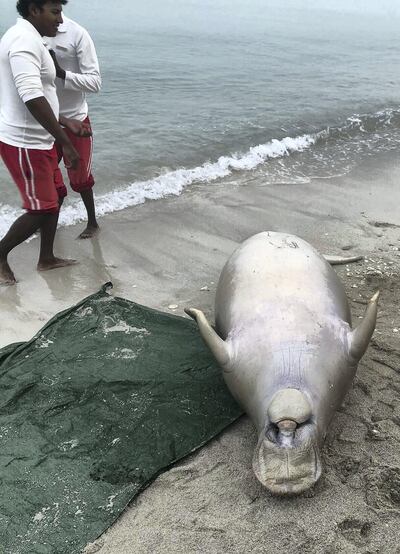A wide-ranging report has detailed efforts by Abu Dhabi to document and fight back against the threats facing the emirate’s environment.
Released on Monday, Environment-Agency Abu Dhabi’s report for 2017 tracks performance across air quality, climate change, groundwater, waste management, marine biodiversity and more.
Marine life in Abu Dhabi, like much of the world, is under threat from "climate change, rising water temperatures, marine pollutants, population growth and increasing coastal development" and the agency is hard at work here. It documented at least 17 dugong (sea cow) deaths last year with nine attributed to drowning from nets. These incidents were swiftly followed by increased monitoring and meetings with fishermen.
Also reported was extensive damage to corals following a strong El Niño in 2016 and 2017. El Niño is a short-term Pacific Ocean weather pattern that causes waters to warm resulting in bleaching of coral which can be followed by their death. “On average, across all of our monitored sites, the amount of coral mortality associated with the 2017 bleaching event was approximately two thirds (63.3 per cent) representing a catastrophic loss to this critical marine habitat,” the report said.
Coming in shark week, the report said that the populations of sharks, rays and chimaeras in the Arabian seas are “some of the most threatened in the world, due to very high pressures from fisheries and particularly bycatch”. The report also makes for sobering reading in terms of turtles with the agency reporting that the 160 Hawksbill turtle nests recorded in 2017 were the lowest in the last decade.
The agency is taking swift action, however, to combat these issues. One of this year’s major achievements was the completion of a survey of the UAE’s demersal fish stocks, the most comprehensive ever completed in the UAE.
About 200 species of fish, sharks and rays were surveyed and the results will inform a comprehensive "fisheries recovery plan" for the UAE, which will be unveiled this year. The UAE's demersal fish stocks are severely over-exploited, with the adult stock sizes of hammour at less than 10 per cent of un-exploited levels. In terms of marine water quality, it found that harmful algal bloom incidents in Abu Dhabi waters decreased from 24 in 2016 to 18 in 2017.
_______________
Read more:
Special report: Abu Dhabi's dwindling water reserves charted in worrying Sorbonne research
Water shortages now a 'huge concern' for UAE, says Energy Minister
Third of Gulf's marine life could be extinct by 2090, study finds
_______________
Turning to waste management, the report details two ambitious national targets set for 2021. The first aims to reduce municipal solid waste generation to 1.5kg a person per day and the second aims to increase the amount of treated municipal waste to 75 per cent. Currently the amount of treated waste stands at about 30 per cent. Recycling is also central to this and the recent emergence of dedicated recycling depots in Abu Dhabi underlines this commitment.
Also critical to the emirate is the preservation of vital groundwater supplies. A recent report predicted that UAE groundwater supplies could be gone in just 50 years. Throughout 2017, about 118,000 wells across Abu Dhabi were surveyed by the EAD and a groundwater altas is expected during 2018 which will inform moves to enhance water security.
The year also saw the completion of the "Liwa Strategic Water Reserve" - a joint project between the EAD and the Abu Dhabi Water and Electricity Authority - which recharges the Liwa aquifer with desalinated water. "The total injected desalinated water is about 25.5 million cubic metres, equivalent to providing around 180 litres day for the population of Abu Dhabi for 90 days in case of an emergency," the report said.
The agency has also been hard at work tracking and conserving the emirate's flora and fauna. The 2017 breeding season saw a record number of 448 greater flamingo chicks successfully fledged at Al Wathba Wetland Reserve. On the off-shore islands, numbers of breeding Socotra cormorants increased to more than 50,000 pairs, the highest population recorded in the last two decades. On the Arabian oryx, EAD teams found 835 individual animals in the protected area, indicating the continued success of the "Sheikh Mohammed bin Zayed Arabian Oryx Reintroduction Programme", which launched in 2007 with just 160 oryx. Using camera traps on Jebel Hafeet, sightings of the extremely endangered Arabian tahr increased at a number of locations.
Last year marked the 20th anniversary of the EAD and more work lies ahead. “As we look back over the last two decades, it has been a wonderful opportunity to step back and reflect on everything we have achieved – from protecting our emirate’s natural resources and biodiversity, to achieving ambitious environmental targets in order to safeguard the future for the next generation,” said Mohammed Al Bowardi, Minister of State for Defence Affairs and managing director of Environment Agency - Abu Dhabi.
Razan Al Mubarak, secretary general of EAD, said: “We have continued to carry out our essential work in protecting and conserving the environment and championing sustainable development within Abu Dhabi emirate and beyond."



